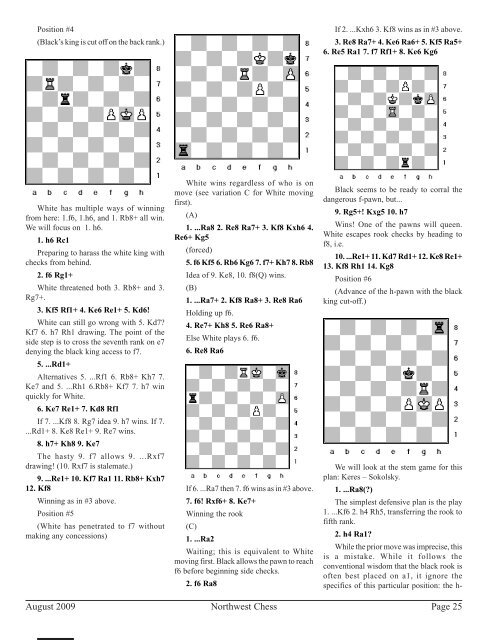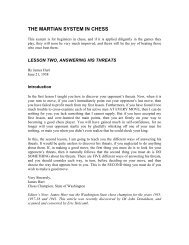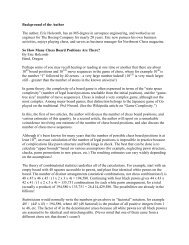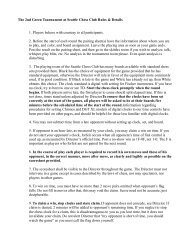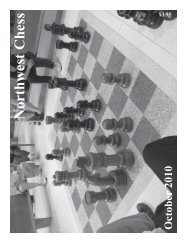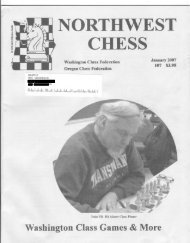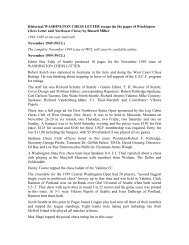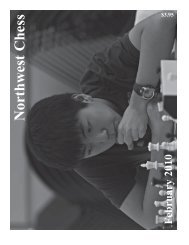Create successful ePaper yourself
Turn your PDF publications into a flip-book with our unique Google optimized e-Paper software.
Position #4<br />
(Black’s king is cut off on the back rank.)<br />
If 2. ...Kxh6 3. Kf8 wins as in #3 above.<br />
3. Re8 Ra7+ 4. Ke6 Ra6+ 5. Kf5 Ra5+<br />
6. Re5 Ra1 7. f7 Rf1+ 8. Ke6 Kg6<br />
White has multiple ways of winning<br />
from here: 1.f6, 1.h6, and 1. Rb8+ all win.<br />
We will focus on 1. h6.<br />
1. h6 Rc1<br />
Preparing to harass the white king with<br />
checks from behind.<br />
2. f6 Rg1+<br />
White threatened both 3. Rb8+ and 3.<br />
Rg7+.<br />
3. Kf5 Rf1+ 4. Ke6 Re1+ 5. Kd6!<br />
White can still go wrong with 5. Kd7?<br />
Kf7 6. h7 Rh1 drawing. The point of the<br />
side step is to cross the seventh rank on e7<br />
denying the black king access to f7.<br />
5. ...Rd1+<br />
Alternatives 5. ...Rf1 6. Rb8+ Kh7 7.<br />
Ke7 and 5. ...Rh1 6.Rb8+ Kf7 7. h7 win<br />
quickly for White.<br />
6. Ke7 Re1+ 7. Kd8 Rf1<br />
If 7. ...Kf8 8. Rg7 idea 9. h7 wins. If 7.<br />
...Rd1+ 8. Ke8 Re1+ 9. Re7 wins.<br />
8. h7+ Kh8 9. Ke7<br />
The hasty 9. f7 allows 9. ...Rxf7<br />
drawing! (10. Rxf7 is stalemate.)<br />
9. ...Re1+ 10. Kf7 Ra1 11. Rb8+ Kxh7<br />
12. Kf8<br />
Winning as in #3 above.<br />
Position #5<br />
(White has penetrated to f7 without<br />
making any concessions)<br />
White wins regardless of who is on<br />
move (see variation C for White moving<br />
first).<br />
(A)<br />
1. ...Ra8 2. Re8 Ra7+ 3. Kf8 Kxh6 4.<br />
Re6+ Kg5<br />
(forced)<br />
5. f6 Kf5 6. Rb6 Kg6 7. f7+ Kh7 8. Rb8<br />
Idea of 9. Ke8, 10. f8(Q) wins.<br />
(B)<br />
1. ...Ra7+ 2. Kf8 Ra8+ 3. Re8 Ra6<br />
Holding up f6.<br />
4. Re7+ Kh8 5. Re6 Ra8+<br />
Else White plays 6. f6.<br />
6. Re8 Ra6<br />
If 6. ...Ra7 then 7. f6 wins as in #3 above.<br />
7. f6! Rxf6+ 8. Ke7+<br />
Winning the rook<br />
(C)<br />
1. ...Ra2<br />
Waiting; this is equivalent to White<br />
moving first. Black allows the pawn to reach<br />
f6 before beginning side checks.<br />
2. f6 Ra8<br />
Black seems to be ready to corral the<br />
dangerous f-pawn, but...<br />
9. Rg5+! Kxg5 10. h7<br />
Wins! One of the pawns will queen.<br />
White escapes rook checks by heading to<br />
f8, i.e.<br />
10. ...Re1+ 11. Kd7 Rd1+ 12. Ke8 Re1+<br />
13. Kf8 Rh1 14. Kg8<br />
Position #6<br />
(Advance of the h-pawn with the black<br />
king cut-off.)<br />
We will look at the stem game for this<br />
plan: Keres – Sokolsky.<br />
1. ...Ra8(?)<br />
The simplest defensive plan is the play<br />
1. ...Kf6 2. h4 Rh5, transferring the rook to<br />
fifth rank.<br />
2. h4 Ra1?<br />
While the prior move was imprecise, this<br />
is a mistake. While it follows the<br />
conventional wisdom that the black rook is<br />
often best placed on a1, it ignore the<br />
specifics of this particular position: the h-<br />
August 2009 <strong>Northwest</strong> <strong>Chess</strong> Page 25


